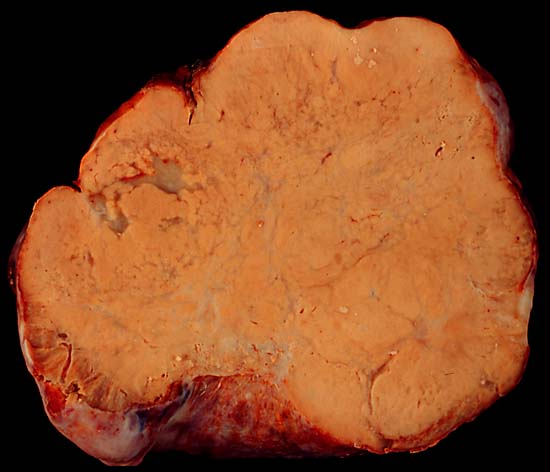Krukenberg tumor
| Krukenberg tumor | ||
 | ||
|---|---|---|
| Krukenberg tumor | ||
| ICD-10 | C56 | |
| ICD-9 | 183 | |
| ICD-O: | 8490/6 | |
| DiseasesDB | 30081 | |
| MeSH | C04.557.470.200.025.415.410 | |
|
WikiDoc Resources for Krukenberg tumor |
|
Articles |
|---|
|
Most recent articles on Krukenberg tumor Most cited articles on Krukenberg tumor |
|
Media |
|
Powerpoint slides on Krukenberg tumor |
|
Evidence Based Medicine |
|
Clinical Trials |
|
Ongoing Trials on Krukenberg tumor at Clinical Trials.gov Trial results on Krukenberg tumor Clinical Trials on Krukenberg tumor at Google
|
|
Guidelines / Policies / Govt |
|
US National Guidelines Clearinghouse on Krukenberg tumor NICE Guidance on Krukenberg tumor
|
|
Books |
|
News |
|
Commentary |
|
Definitions |
|
Patient Resources / Community |
|
Patient resources on Krukenberg tumor Discussion groups on Krukenberg tumor Patient Handouts on Krukenberg tumor Directions to Hospitals Treating Krukenberg tumor Risk calculators and risk factors for Krukenberg tumor
|
|
Healthcare Provider Resources |
|
Causes & Risk Factors for Krukenberg tumor |
|
Continuing Medical Education (CME) |
|
International |
|
|
|
Business |
|
Experimental / Informatics |
Editor-In-Chief: C. Michael Gibson, M.S., M.D. [1]
Overview
A Krukenberg tumor classically refers to a secondary ovarian malignancy whose primary site arose in the gastrointestinal tract. Krukenberg tumors are often found in both ovaries. Microscopically, they are characterized by appearance of mucin-secreting signet-ring cells in the tissue of the ovary; when the primary tumor is discovered, the same signet-ring cells will be found.
Historical
The Krukenberg tumor is named after Friedrich Ernst Krukenberg (1871-1946), a German doctor who first described them as "fibrosarcoma ovarii mucocellulare carcinomatodes". A short biography of Krukenberg can be found at WhoNamedIt.com
Etiology and Incidence
Metastatic cancer of the ovary accounts for only about 5% of ovarian cancer; in the remainder, the ovary is the primary cancer site. Krukenberg tumors are the third most common metastatic ovarian cancer (after epithelial and germ-cell tumors) and make up 14% of these cancers. Unlike some forms of cancer, there is no racial bias. Krukenberg tumors are most commonly seen in middle-aged and elderly females, around or following the menopause.
Symptoms
Patients with Krukenberg tumor often come to the attention of their doctor when they present complaining of abdominal or pelvic pain, bloatedness, vaginal bleeding, a change in their menstrual habit or pain during intercourse. These symptoms are non-specific (i.e. they point to a range of problems other than cancer) and a diagnosis can only be made following Computed Tomography (CT) scans, laparotomy and/or a biopsy of the ovary.
Pathogenesis
There is some debate over the exact mechanism of metastasis of the tumour cells from the stomach, appendix or colon to the ovaries; classically it was thought that direct seeding across the abdominal cavity accounted for the spread of this tumor, but recently some researchers have suggested that lymphatic (i.e. through the lymph nodes), or haematogenous (i.e. through the blood) spread is more likely, as most of these tumours are found on the inside of the ovaries. Proponents of this theory cite the fact that metastases are never found in the omentum (the fatty apron which envelops the organs of the abdomen and lies between the stomach and ovaries), and that the tumor cells are found within the ovary and not growing inwards. However, this remains a controversy, as cases in Hong Kong always showed omental spread and peritoneal seedlings in patients with Krukenberg tumours.
Although a Krukenberg tumor is most commonly a metastasis from a gastric cancer (usually an adenocarcinoma), this is not always the case. Other tumours of the gastrointestinal tract (including, significantly, colon cancer) have been known to cause Krukenberg tumours, and recent case-reports of Krukenberg tumors originating from tumors of the tip of the appendix have appeared in the medical literature.
Treatment and Prognosis
Since the Krukenberg tumor is a secondary (metastatic) tumor, management of the tumor must involve finding and treating the primary cancer. In general, most cases of Krukenberg tumor have a poor prognosis and radical operation such as removal of the ovaries (and the colon or appendix if involved) can improve survival only in cases of solitary ovarian metastasis or local extended disease (i.e. the lesion is located only in the pelvis). Cancer chemotherapy and radiotherapy before surgery may be used to shrink the tumor and facilitate its removal.